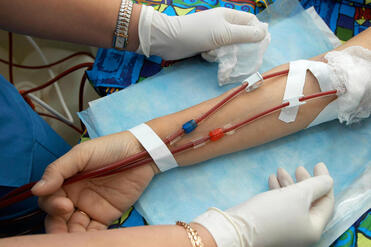What Is Dialysis?
Dialysis is a treatment that filters and purifies the blood using a machine. This helps keep your fluids and electrolytes in balance when the kidneys can't do their job. Dialysis has been used since the 1940s to treat people with kidney problems.
What are the Types of Dialysis Treatment?
Other than filtering wastes and toxins from your blood, the kidneys are also important for blood cell production and bone health. When your kidneys aren’t working properly due to such conditions as advanced chronic kidney disease (renal failure) or hypercalcemia, your physician may determine that dialysis is needed. Dialysis may be recommended on a temporary or more permanent basis until a kidney transplant donor can be found.
Hope Dialysis Center does one type of kidney dialysis treatment:
Hope Dialysis Center does one type of kidney dialysis treatment:
- Hemodialysis is where the blood is taken out of the body, filtered by a machine and then returned to the body. This type of treatment usually takes place three times a week, for a period of roughly four hours, at a center, hospital or sometimes in your home.
How Is Access for Dialysis Treatment Attained?

With hemodialysis the vascular surgeon needs to create an access portal. There are two types of portals that are placed under the skin:
These access ports cause more blood to flow through the vein and allow it to be strengthened and stretched for a more efficient dialysis treatment. Fistulas can take three to six months to fully develop and are more resistant to infection but may not be a viable option in someone who has reduced circulation due to atherosclerosis or a hardening of the arteries. Grafts can be used within two to six weeks when the vein has sufficiently healed.
Hope Dialysis Center's physician Dr. Letarte, will monitor your dialysis access of the fistulas and grafts. If blood clots form, interventional radiology can be used for mechanical and pharmacologic thrombolysis.
- Fistula - which the surgeon constructs by joining an artery to a vein
- Graft - a plastic tube inserted under the skin to connect and artery to a vein
These access ports cause more blood to flow through the vein and allow it to be strengthened and stretched for a more efficient dialysis treatment. Fistulas can take three to six months to fully develop and are more resistant to infection but may not be a viable option in someone who has reduced circulation due to atherosclerosis or a hardening of the arteries. Grafts can be used within two to six weeks when the vein has sufficiently healed.
Hope Dialysis Center's physician Dr. Letarte, will monitor your dialysis access of the fistulas and grafts. If blood clots form, interventional radiology can be used for mechanical and pharmacologic thrombolysis.
What Can I Expect After Dialysis?
With either type of dialysis there can be some side effects and both types can really drain your energy and make you feel tired. Hemodialysis can cause itchy skin, clotting, narrowing, aneurysm in the access or infection and bleeding; while peritoneal dialysis can lead to a greater risk for infection of the abdominal membrane called peritonitis.
Many people on dialysis have a good quality of life and can remain on dialysis for years. People who are otherwise healthy should be able to continue driving, swimming, maintaining light exercise or even working.
Many people on dialysis have a good quality of life and can remain on dialysis for years. People who are otherwise healthy should be able to continue driving, swimming, maintaining light exercise or even working.
Hours of OperationMon - Sat: 7am - 5pm
Sun: Closed |
Contact Information |

